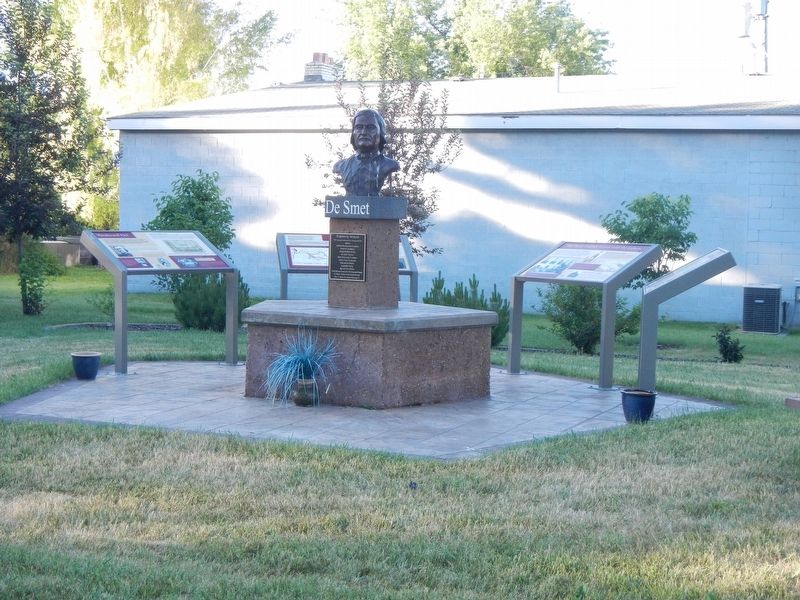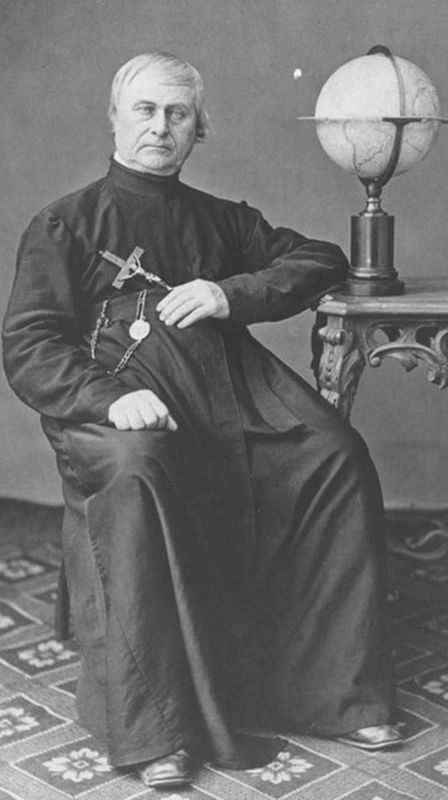Soda Springs in Caribou County, Idaho — The American West (Mountains)
Father De Smet Monument
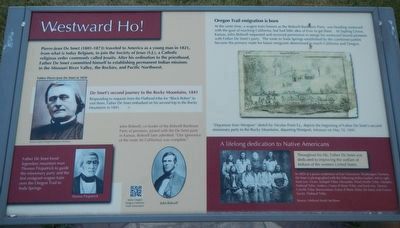
Photographed By Barry Swackhamer, June 22, 2017
1. Westward Ho!
Captions: (center left) Father Pierre-Jean De Smet in 1858; (bottom left) Father De Smet hired legendary mountain man Thomas Fitzpatrick to guide the missionary party and the first emigrant wagon train over the Oregon Trail to Soda Springs.; (bottom center) John Bidwell, co-leader of the Bidwell-Bartleson Party of pioneers, joined with the De Smet party in Kansas. Bidwell later admitted: "Our ignorance of the route (to California) was complete."; (center right) "Departure from Westport" sketched by Nicholas Point S.J. depicts the beginning of Father De Smet's second missionary party to Rocky Mountains, departing Westport on May 10, 1841.; (bottom right) In 1859 at a peace conference at Fort Vancouver, Washington Territory, De Smet is photographed with the following Indian leaders, left to right, front row: Victor, Kalipel Tribe; Alexander, Pend Oreille Tribe; Adolphe, Flathead Tribe; Andrew, Coeur d'Alene Tribe: and back row. Dennis, Colville Tribe; Bonaventure, Coeur d'Alene Tribe; De Smet and Francis Xavier, Flathead Tribe.
Pierre-Jean De Smet (1801-1873) traveled to America as a young man in 1821, from what is today Belgium, to join the Society of Jesus (S.J.), a Catholic religious order commonly called Jesuits. After his ordination to the priesthood, Father De Smet committed himself to establishing permanent Indian missions in the Missouri River Valley, the Rockies, and Pacific Northwest.
De Smet's second journey to the Rocky Mountains, 1841
Responding to requests from the Flathead tribe for "Black Robes" to visit them. Father De Smet embarked on his second trip to the Rocky Mountains in 1841.
Oregon Trail emigration is born
At the same time, a wagon train known as the Bidwell-Bartleson Party, was heading westward with the goal of reaching California, but had little idea of how to get there. At Sapling Grove, Kansas, John Bidwell requested and received permission to merge his westward bound pioneers with Father De Smet's party. The route to Soda Springs established by the combined parties became the primary route for future emigrants determined to reach California and Oregon.
A lifelong dedication to Native Americans
Throughout his life, Father De Smet was dedicated to improving the welfare of Indians of the western United States.
The combined 81-member De Smet and Bidwell-Bartleson parties headed west from Kansas to the Soda Springs area on the Bear River, arriving on August 10, 1841. The Bidwell-Bartleson Party consisted of 69 members.
Father De Smet was joined by Thomas Fitzpatrick, guide, Nicolas Point S.J., French artist, architect, and college educator; Gregory Mengarini S.J., Italian linguist, physician, and musician; three lay brothers, teamsters and a professional hunter.
Soda Springs, a place of great natural curiosities
In his writings, Father De Smet described his observations in Soda Springs area:
"Some places on Bear River exhibit great natural curiosities. A square plain presents an even surface of fuller's earth of pure whiteness, like that of marble. Situated near this plain are a great many springs, differing in size and temperature. Several of them have a slight taste of soda, and the temperature of these is cold... In the same locality there is a remarkable spring... from this hole issue alternately a jet of water and a gush of steam. The earth for some distance around resounds like an immense vault, and is apt to frighten
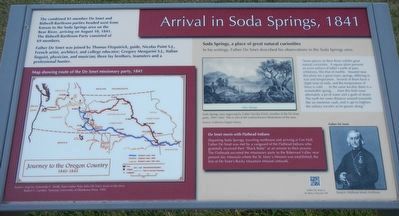
Photographed By Barry Swackhamer, June 22, 2017
2. Arrival in Soda Springs, 1841
Caption: (map, bottom left) Map showing route of De Smet missionary party, 1841.; (center) Soda Springs area engraving by Father Nicolas Point, member of the De Smet party, 1841-1842. This is one of the earliest known illustrations of the area.; (bottom right) Father De Smet.
De Smet meets with Flathead
Departing Soda Springs, traveling northwest and arriving at Fort Hall, Father De Smet was met by a vanguard of the Flathead Indians who gratefully received their "Black Rove" as an answer to their prayers. The Flatheads escorted the missionary party to the Bitterroot Valley near present day Missoula where the St. Mary's Mission was established, the first of De. Smet's Rocky Mountain Mission network.
There was no single person the American Indians trusted as they did Father De Smet. He was described by one Indian leader as "the white man whose tongue does not lie" and described as "more powerful than an army" at an Indian treaty conference at Fort Laramie in 1851. Father De Smet was invited to the White House in 1867 to advise on Indian affairs and in 1869 he helped lead negotiations at a peace conference with Sitting Bull of the Sioux.
Just and honest treatment of Indians
Father De Smet's philosophy was that just and honest treatment of Indians was the surest way to keep peace with them. Father De Smet gave Sitting Bull of the Sioux a crucifix as a sign of the fervent hope which both men shared that the power of the Great Spirit would bring peace and security
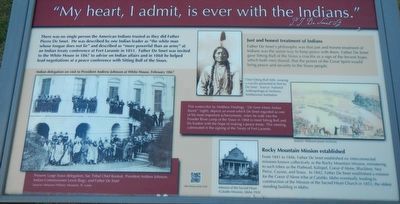
Photographed By Barry Swackhamer, June 22, 2017
3. "My heart, I admit, is ever with the Indians."
Captions: (lower left) Indian delegation on visit to President Andrew Johnson at White House, 1867. Present: Large Sioux delegation, Sac Tribal Chief Keokuk, Present Andrew Johnson, Indian Commissionere Lewis Bogy, and Father De Smet.; (upper center) Chief Sitting Bull wearing a crucifix presented to him by De Smet.; (center right) This watercolor by Matthew Hastings, "De Smet Meets Indian Bands" depicts an event which De Smet regarded as one of his most important achievements when he rode into the Powder River camp of the Sioux in 1868 to meet Sitting Bull and his leaders with the hope of making a peace treaty. This meeting culminated in the signing of the Treaty of Fort Laramie.; (bottom center) Mission of the Sacred Heart (Cataldo Mission), Idaho 1920.
Rocky Mountain Mission established
From 1841 to 1846, Father De Smet established six interconnected missions known collectively as the Rock Mountain Mission, ministering to such tribes as the Flathead, Kalispel, Coeur d'Alene, Blackfeet, Nez Perce, Cayuse, and Sioux. In 1842, Father De Smet established a mission for the Coeur d'Alene tribe at Cataldo, Idaho eventually leading to construction of the Mission of the Sacred Heart Church in 1853, the oldest standing building in Idaho.
Father Pierre De Smet traveled to the West 18 times, crossed the Atlantic Ocean 19 times, and sailed around Cape Horn in the course of his work as a frontier missionary, peacemaker, educator, and author. From 1821-1879, his travels over land and sea amounted to over 180,000 miles.
Father De Smet was one of the best traveled frontiersmen of his day. He kept meticulous journals of his travels to the West and authored four books and numerous letters that were at the time and are now highly regarded for their accurate and insightful description of western lands and its native peoples.
The Linton Album, a remarkable scrapbook
Physician Dr. Moses Linton was a close friend of Father De Smet's and presented De Smet with this album to be used as a
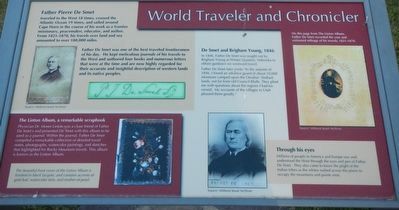
Photographed By Barry Swackhamer, June 22, 2017
4. World Traveler and Chronicler
Captions: (upper left) Father Pierre De Smet and his signature; (bottom left) The beautiful front cover of the Linton Album is finished in black lacquer, and contains accents of gold leaf, watercolor tints, and mother-of-pearl.; (upper right) On this page from The Linton Album. Father De Smet recorded the year and estimated mileage of his travels, 1821-1870. (lower right) Father De Smet.
De Smet and Brigham Young, 1846
In 1846, Father De Smet was sought out by Brigham Young at Winter Quarters, Nebraska to obtain guidance on western travel.
Father De Smet later wrote "In the autumn of 1846, I found an advance guard of about 10,000 Mormons camped upon the Omahas' (Indian) lands, not far from old Council Bluffs. They plied me with questions about the regions I had traversed. My accounts of the villages in Utah please them greatly."
Through his eyes
Millions of people in America and Europe saw and understood the West through the eyes and pen of Father De Smet. They also came to know the plight of the Indian tribes as the whites rushed across the plains to occupy the mountains and points west.
Erected by St. Mary's Catholic Church.
Topics. This historical marker and monument is listed in these topic lists: Churches & Religion • Native Americans.
Location. 42° 39.336′ N, 111° 36.378′ W. Marker is in Soda Springs, Idaho, in Caribou County. Marker is on West Center Street near South 1st Street West, on the left when traveling west. Touch for map. Marker is at or near this postal address: 42 West Center Street, Soda Springs ID 83276, United States of America. Touch for directions.
Other nearby markers. At least 8 other markers are within walking distance of this marker. Not A Walk In The Park... (within shouting distance of this marker); Wagon Box Grave of 1861 (about 400 feet away, measured in a direct line); Niels Anderson ---- Mary Christoffersen Anderson (about 400 feet away); Ground Observer Corps National Campaign (about 400 feet away); Ground Observation Corps Soda Springs Post (about 500 feet away); Ground Observer Corps National Planning (about 500 feet away); George W. and Leah Wallet Gorton (about 600 feet away); "It Roars Like a Mad Dragon" (about 600 feet away). Touch for a list and map of all markers in Soda Springs.
More about this monument. The monument is next to St. Mary's Catholic Church
Also see . . . De Smet, Pierre-Jean (1801-1873) - Encyclopedia of the Great Plains. Following more than a decade of religious formation, De Smet began his missionary career in 1838 when he established Saint Joseph's Mission for members of the Potawatomi tribe at Council Bluffs. From that date until his death, De Smet baptized many thousands of Native Americans in more than thirty tribes. (Submitted on August 10, 2017, by Barry Swackhamer of Brentwood, California.)
Additional commentary.
1. Additional Historical Information
Thank you, Mr. Swackhamer, for your accurate entry of this monument into the database. As the person who authored the interpretive panels and built the monument in 2013, there is one piece of information that I wish I had included but did not. That is, that the professional hunter of the De Smet Party that was mentioned in the first paragraph of the "Arrival in Soda Springs" panel was Iroquois Indian John Gray, for whom nearby Gray's Lake is named.
— Submitted November 14, 2017, by Donald Wind of Rigby, Idaho.
Credits. This page was last revised on December 31, 2017. It was originally submitted on August 10, 2017, by Barry Swackhamer of Brentwood, California. This page has been viewed 884 times since then and 73 times this year. Photos: 1, 2, 3, 4, 5, 6. submitted on August 10, 2017, by Barry Swackhamer of Brentwood, California.
